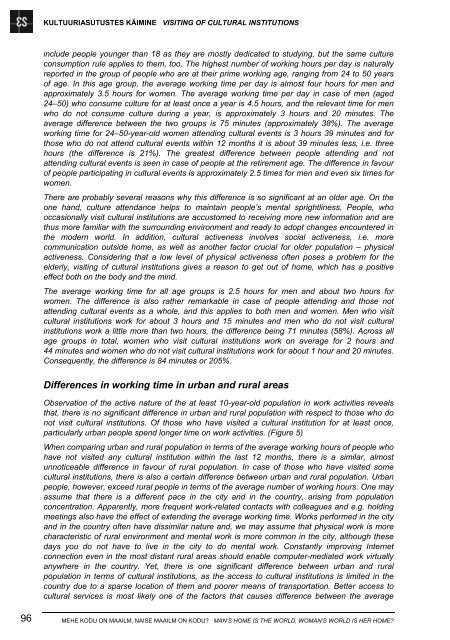MEHE KODU ON MAAILM, NAISE MAAILM ON KODU? - Tartu Ãlikool
MEHE KODU ON MAAILM, NAISE MAAILM ON KODU? - Tartu Ãlikool
MEHE KODU ON MAAILM, NAISE MAAILM ON KODU? - Tartu Ãlikool
You also want an ePaper? Increase the reach of your titles
YUMPU automatically turns print PDFs into web optimized ePapers that Google loves.
KULTUURIASUTUSTES KÄIMINE VISITING OF CULTURAL INSTITUTI<strong>ON</strong>S<br />
include people younger than 18 as they are mostly dedicated to studying, but the same culture<br />
consumption rule applies to them, too. The highest number of working hours per day is naturally<br />
reported in the group of people who are at their prime working age, ranging from 24 to 50 years<br />
of age. In this age group, the average working time per day is almost four hours for men and<br />
approximately 3.5 hours for women. The average working time per day in case of men (aged<br />
24–50) who consume culture for at least once a year is 4.5 hours, and the relevant time for men<br />
who do not consume culture during a year, is approximately 3 hours and 20 minutes. The<br />
average difference between the two groups is 75 minutes (approximately 38%). The average<br />
working time for 24–50-year-old women attending cultural events is 3 hours 39 minutes and for<br />
those who do not attend cultural events within 12 months it is about 39 minutes less, i.e. three<br />
hours (the difference is 21%). The greatest difference between people attending and not<br />
attending cultural events is seen in case of people at the retirement age. The difference in favour<br />
of people participating in cultural events is approximately 2.5 times for men and even six times for<br />
women.<br />
There are probably several reasons why this difference is so significant at an older age. On the<br />
one hand, culture attendance helps to maintain people’s mental sprightliness. People, who<br />
occasionally visit cultural institutions are accustomed to receiving more new information and are<br />
thus more familiar with the surrounding environment and ready to adopt changes encountered in<br />
the modern world. In addition, cultural activeness involves social activeness, i.e. more<br />
communication outside home, as well as another factor crucial for older population – physical<br />
activeness. Considering that a low level of physical activeness often poses a problem for the<br />
elderly, visiting of cultural institutions gives a reason to get out of home, which has a positive<br />
effect both on the body and the mind.<br />
The average working time for all age groups is 2.5 hours for men and about two hours for<br />
women. The difference is also rather remarkable in case of people attending and those not<br />
attending cultural events as a whole, and this applies to both men and women. Men who visit<br />
cultural institutions work for about 3 hours and 15 minutes and men who do not visit cultural<br />
institutions work a little more than two hours, the difference being 71 minutes (58%). Across all<br />
age groups in total, women who visit cultural institutions work on average for 2 hours and<br />
44 minutes and women who do not visit cultural institutions work for about 1 hour and 20 minutes.<br />
Consequently, the difference is 84 minutes or 205%.<br />
Differences in working time in urban and rural areas<br />
Observation of the active nature of the at least 10-year-old population in work activities reveals<br />
that, there is no significant difference in urban and rural population with respect to those who do<br />
not visit cultural institutions. Of those who have visited a cultural institution for at least once,<br />
particularly urban people spend longer time on work activities. (Figure 5)<br />
When comparing urban and rural population in terms of the average working hours of people who<br />
have not visited any cultural institution within the last 12 months, there is a similar, almost<br />
unnoticeable difference in favour of rural population. In case of those who have visited some<br />
cultural institutions, there is also a certain difference between urban and rural population. Urban<br />
people, however, exceed rural people in terms of the average number of working hours. One may<br />
assume that there is a different pace in the city and in the country, arising from population<br />
concentration. Apparently, more frequent work-related contacts with colleagues and e.g. holding<br />
meetings also have the effect of extending the average working time. Works performed in the city<br />
and in the country often have dissimilar nature and, we may assume that physical work is more<br />
characteristic of rural environment and mental work is more common in the city, although these<br />
days you do not have to live in the city to do mental work. Constantly improving Internet<br />
connection even in the most distant rural areas should enable computer-mediated work virtually<br />
anywhere in the country. Yet, there is one significant difference between urban and rural<br />
population in terms of cultural institutions, as the access to cultural institutions is limited in the<br />
country due to a sparse location of them and poorer means of transportation. Better access to<br />
cultural services is most likely one of the factors that causes difference between the average<br />
96<br />
<strong>MEHE</strong> <strong>KODU</strong> <strong>ON</strong> <strong>MAAILM</strong>, <strong>NAISE</strong> <strong>MAAILM</strong> <strong>ON</strong> <strong>KODU</strong>? MAN’S HOME IS THE WORLD, WOMAN’S WORLD IS HER HOME?

















